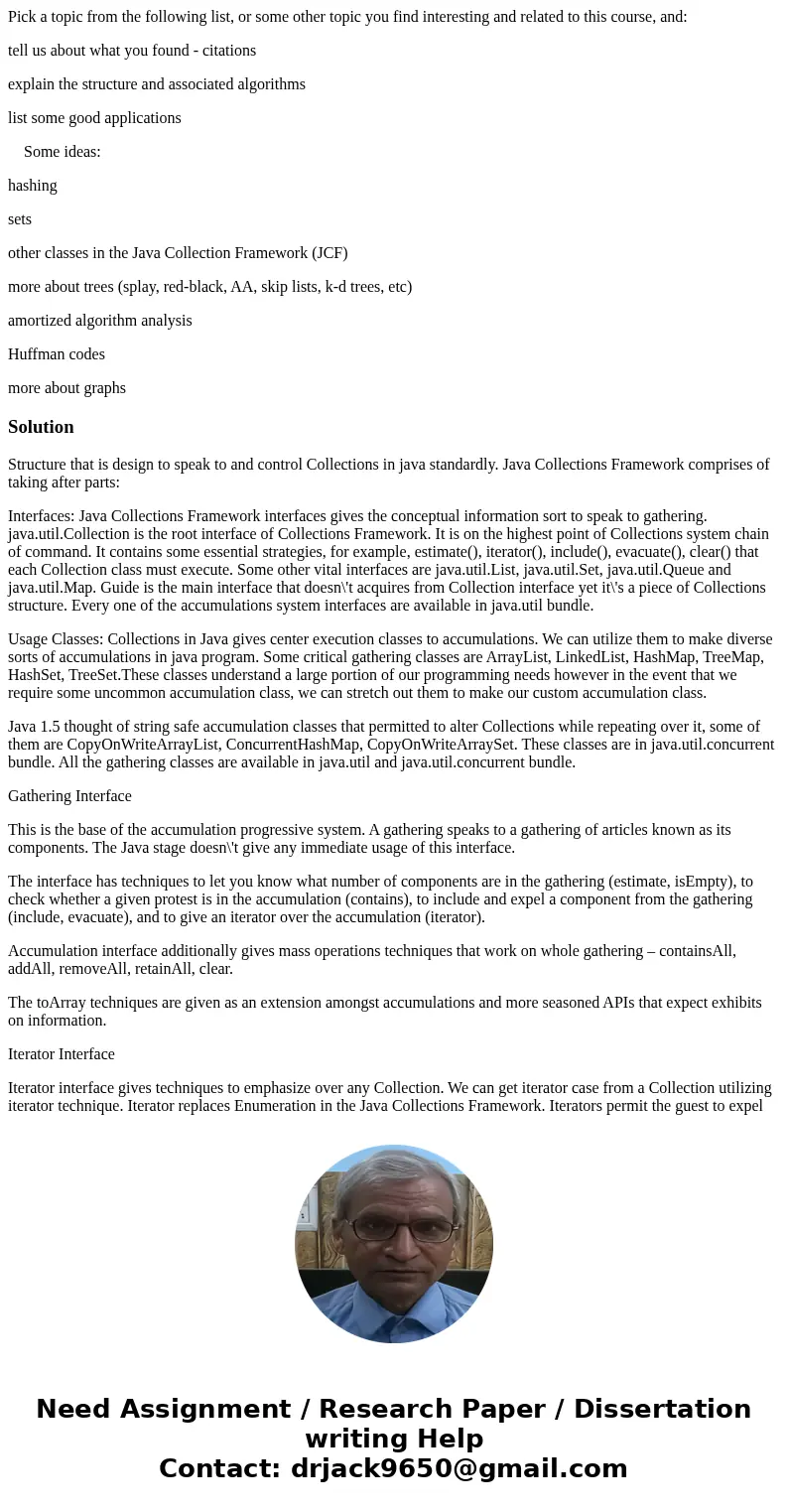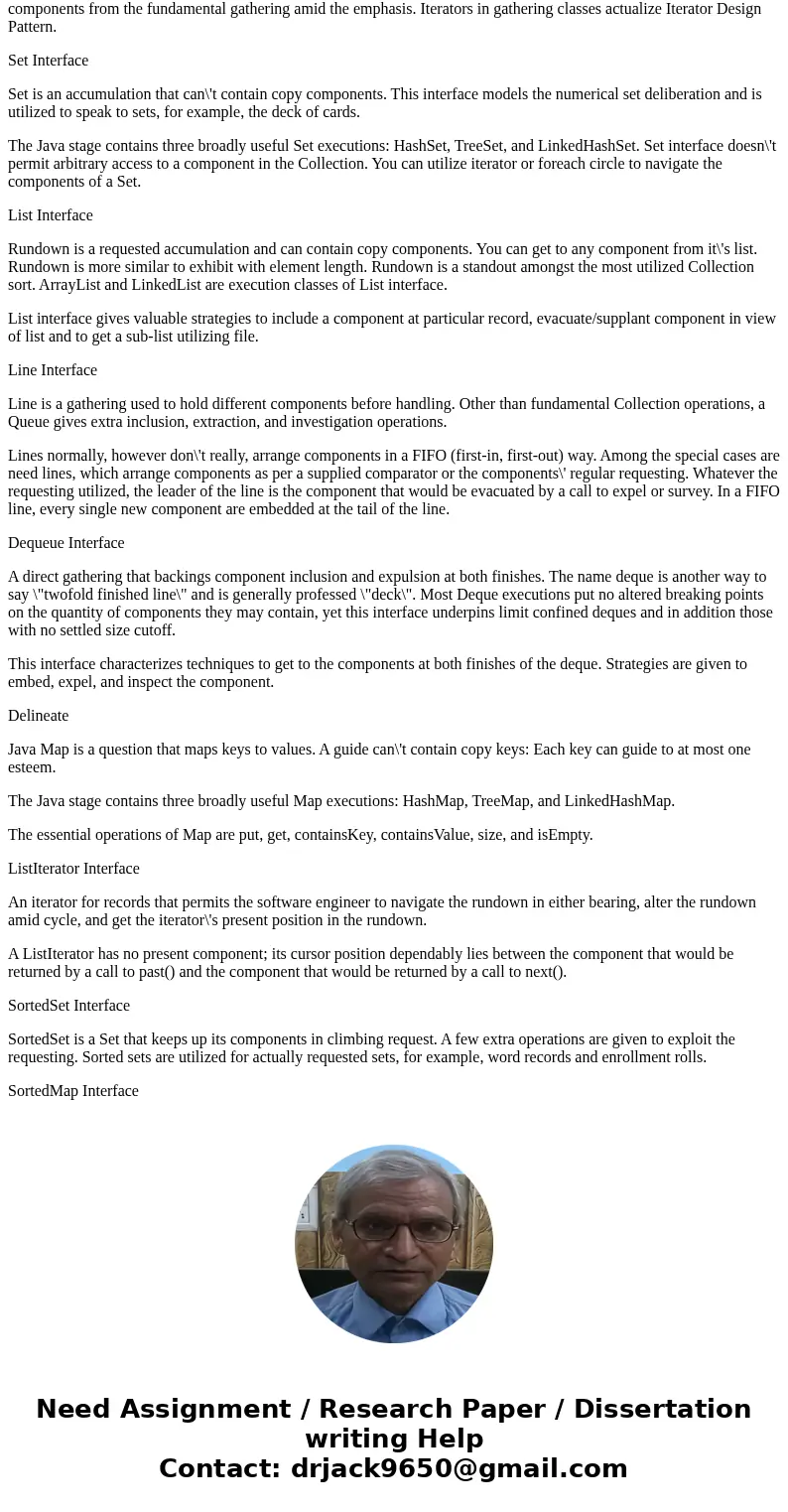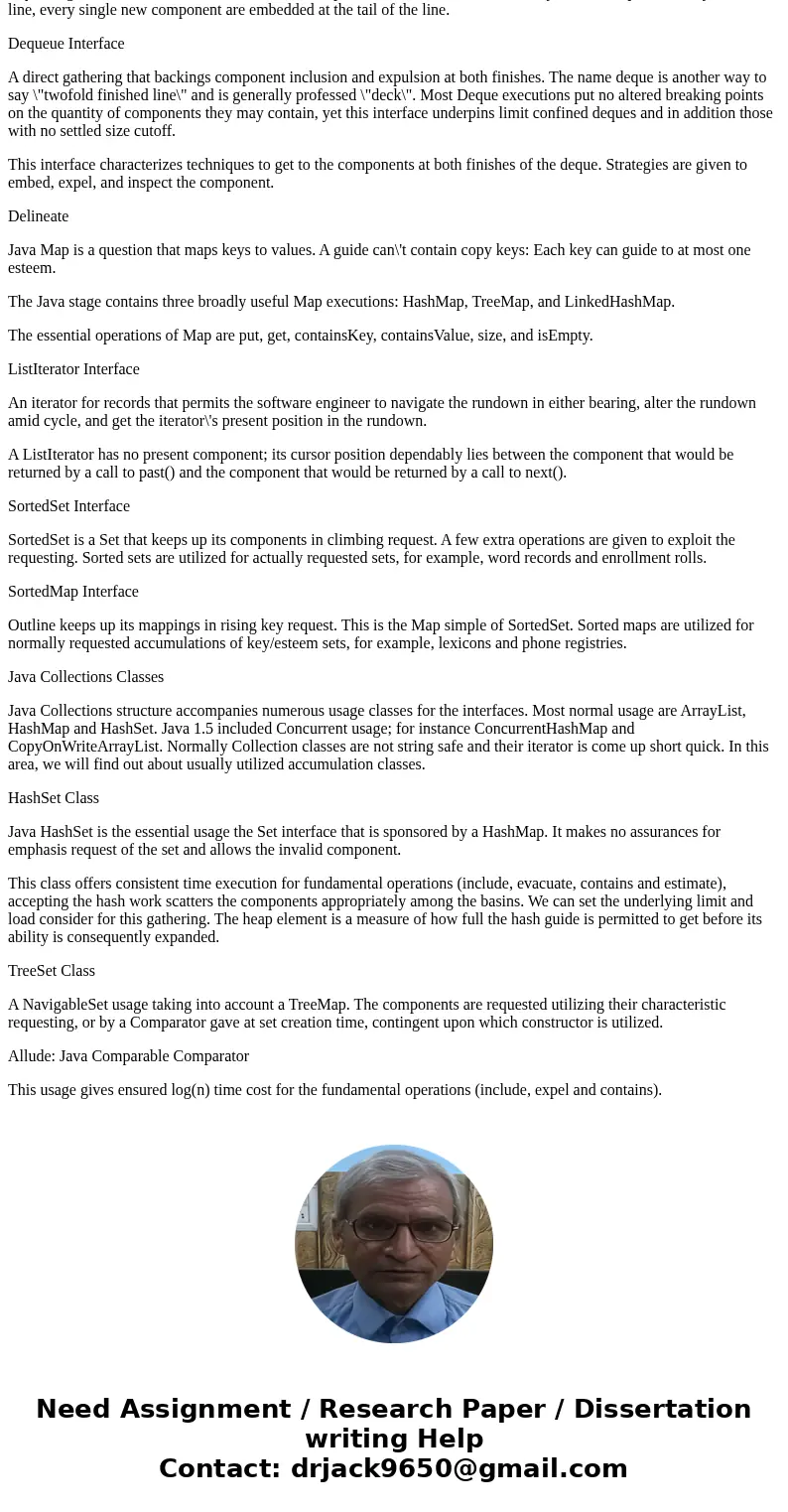Pick a topic from the following list or some other topic you
Pick a topic from the following list, or some other topic you find interesting and related to this course, and:
tell us about what you found - citations
explain the structure and associated algorithms
list some good applications
Some ideas:
hashing
sets
other classes in the Java Collection Framework (JCF)
more about trees (splay, red-black, AA, skip lists, k-d trees, etc)
amortized algorithm analysis
Huffman codes
more about graphs
Solution
Structure that is design to speak to and control Collections in java standardly. Java Collections Framework comprises of taking after parts:
Interfaces: Java Collections Framework interfaces gives the conceptual information sort to speak to gathering. java.util.Collection is the root interface of Collections Framework. It is on the highest point of Collections system chain of command. It contains some essential strategies, for example, estimate(), iterator(), include(), evacuate(), clear() that each Collection class must execute. Some other vital interfaces are java.util.List, java.util.Set, java.util.Queue and java.util.Map. Guide is the main interface that doesn\'t acquires from Collection interface yet it\'s a piece of Collections structure. Every one of the accumulations system interfaces are available in java.util bundle.
Usage Classes: Collections in Java gives center execution classes to accumulations. We can utilize them to make diverse sorts of accumulations in java program. Some critical gathering classes are ArrayList, LinkedList, HashMap, TreeMap, HashSet, TreeSet.These classes understand a large portion of our programming needs however in the event that we require some uncommon accumulation class, we can stretch out them to make our custom accumulation class.
Java 1.5 thought of string safe accumulation classes that permitted to alter Collections while repeating over it, some of them are CopyOnWriteArrayList, ConcurrentHashMap, CopyOnWriteArraySet. These classes are in java.util.concurrent bundle. All the gathering classes are available in java.util and java.util.concurrent bundle.
Gathering Interface
This is the base of the accumulation progressive system. A gathering speaks to a gathering of articles known as its components. The Java stage doesn\'t give any immediate usage of this interface.
The interface has techniques to let you know what number of components are in the gathering (estimate, isEmpty), to check whether a given protest is in the accumulation (contains), to include and expel a component from the gathering (include, evacuate), and to give an iterator over the accumulation (iterator).
Accumulation interface additionally gives mass operations techniques that work on whole gathering – containsAll, addAll, removeAll, retainAll, clear.
The toArray techniques are given as an extension amongst accumulations and more seasoned APIs that expect exhibits on information.
Iterator Interface
Iterator interface gives techniques to emphasize over any Collection. We can get iterator case from a Collection utilizing iterator technique. Iterator replaces Enumeration in the Java Collections Framework. Iterators permit the guest to expel components from the fundamental gathering amid the emphasis. Iterators in gathering classes actualize Iterator Design Pattern.
Set Interface
Set is an accumulation that can\'t contain copy components. This interface models the numerical set deliberation and is utilized to speak to sets, for example, the deck of cards.
The Java stage contains three broadly useful Set executions: HashSet, TreeSet, and LinkedHashSet. Set interface doesn\'t permit arbitrary access to a component in the Collection. You can utilize iterator or foreach circle to navigate the components of a Set.
List Interface
Rundown is a requested accumulation and can contain copy components. You can get to any component from it\'s list. Rundown is more similar to exhibit with element length. Rundown is a standout amongst the most utilized Collection sort. ArrayList and LinkedList are execution classes of List interface.
List interface gives valuable strategies to include a component at particular record, evacuate/supplant component in view of list and to get a sub-list utilizing file.
Line Interface
Line is a gathering used to hold different components before handling. Other than fundamental Collection operations, a Queue gives extra inclusion, extraction, and investigation operations.
Lines normally, however don\'t really, arrange components in a FIFO (first-in, first-out) way. Among the special cases are need lines, which arrange components as per a supplied comparator or the components\' regular requesting. Whatever the requesting utilized, the leader of the line is the component that would be evacuated by a call to expel or survey. In a FIFO line, every single new component are embedded at the tail of the line.
Dequeue Interface
A direct gathering that backings component inclusion and expulsion at both finishes. The name deque is another way to say \"twofold finished line\" and is generally professed \"deck\". Most Deque executions put no altered breaking points on the quantity of components they may contain, yet this interface underpins limit confined deques and in addition those with no settled size cutoff.
This interface characterizes techniques to get to the components at both finishes of the deque. Strategies are given to embed, expel, and inspect the component.
Delineate
Java Map is a question that maps keys to values. A guide can\'t contain copy keys: Each key can guide to at most one esteem.
The Java stage contains three broadly useful Map executions: HashMap, TreeMap, and LinkedHashMap.
The essential operations of Map are put, get, containsKey, containsValue, size, and isEmpty.
ListIterator Interface
An iterator for records that permits the software engineer to navigate the rundown in either bearing, alter the rundown amid cycle, and get the iterator\'s present position in the rundown.
A ListIterator has no present component; its cursor position dependably lies between the component that would be returned by a call to past() and the component that would be returned by a call to next().
SortedSet Interface
SortedSet is a Set that keeps up its components in climbing request. A few extra operations are given to exploit the requesting. Sorted sets are utilized for actually requested sets, for example, word records and enrollment rolls.
SortedMap Interface
Outline keeps up its mappings in rising key request. This is the Map simple of SortedSet. Sorted maps are utilized for normally requested accumulations of key/esteem sets, for example, lexicons and phone registries.
Java Collections Classes
Java Collections structure accompanies numerous usage classes for the interfaces. Most normal usage are ArrayList, HashMap and HashSet. Java 1.5 included Concurrent usage; for instance ConcurrentHashMap and CopyOnWriteArrayList. Normally Collection classes are not string safe and their iterator is come up short quick. In this area, we will find out about usually utilized accumulation classes.
HashSet Class
Java HashSet is the essential usage the Set interface that is sponsored by a HashMap. It makes no assurances for emphasis request of the set and allows the invalid component.
This class offers consistent time execution for fundamental operations (include, evacuate, contains and estimate), accepting the hash work scatters the components appropriately among the basins. We can set the underlying limit and load consider for this gathering. The heap element is a measure of how full the hash guide is permitted to get before its ability is consequently expanded.
TreeSet Class
A NavigableSet usage taking into account a TreeMap. The components are requested utilizing their characteristic requesting, or by a Comparator gave at set creation time, contingent upon which constructor is utilized.
Allude: Java Comparable Comparator
This usage gives ensured log(n) time cost for the fundamental operations (include, expel and contains).



 Homework Sourse
Homework Sourse